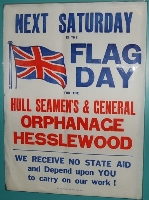Fishy Business!
Hull's fishing industry boomed between the late 19th century and the mid 20th century. Fish merchants played a key role in distributing the catch to the public. While the trawlermen, tired from a long trip, were going ashore, fish merchants would be arriving on St. Andrew's Dock from 6am to examine the catch and decide which batches they would bid for later that day. They would have met a bustling scene, with fish bobbers unloading basket after basket of fresh fish from the trawlers and filleters ready to process it. #SUBHEADING#George Beaumont - Fish Merchant#SUBHEADINGEND# George Robert Beaumont worked as a fish merchant in Hull, and the papers he left give us an interesting insight into his occupation. Trade directories tell us George had his own business from the late 1910s. This was based at Billingsgate market on St. Andrew's Dock - often referred to by locals as the 'Fish Dock'. He lived close by in the City's fishing community district. George became a member of The Hull Fish Merchants' Protection Association, Ltd. in the mid-1930s. This body had been set up in 1890 and is still operating today. The Hull fishing industry faced difficult times in the late 1930s as many of the port's trawlers were requisitioned for war service. Catches became so low that fish merchants struggled to continue trading. Despite these difficulties, George's business survived and continued operating into the late 1950s. A collection of George's correspondence was acquired by Hull Museums in 1995. This includes lists of sales and purchases to various people between 1950 and 1951, telegraphs concerning fish catches at sea and copies of the annual reports of The Hull Fish Merchants' Protection Association, Ltd. for 1934-5 and 1938-40. #SUBHEADING#Advertising his trade#SUBHEADINGEND# Like anyone involved in a competitive industry, fish merchants had to promote their trade. One item amongst George Beaumont's papers is a card blotter which advertised his business. It was used as a marketing technique which would have been distributed to potential and existing customers. The blotter served both a decorative and practical purpose. It would have been kept on a desk and used to absorb the excess ink from letters and accounts, etc., which resulted from writing with fountain pens. It is easy to imagine how such a useful tool could serve as a constant reminder of this fish merchant's business, with his contact details always to hand. The picture shown is of a scene at Robin Hood's Bay. Why this small fishing village on the North Yorkshire Coast was depicted rather than a scene of Hull's fishing industry is unknown. Maybe it was intended to represent the quality catch linked to a traditional fishing haven, or perhaps George Beaumont simply liked the picture. The exact date when the blotter was made is unknown, but it was certainly after 1937 when George Beaumont adopted the telephone number printed onto the front.
 Hull Seamen's General Orphanage
Hull Seamen's General Orphanage
Hull Seamen's and General Orphan Society was established at Spring Bank in 1865. It was set up to house children whose fathers had been lost at sea.
 Silver Cod Trophy
Silver Cod Trophy
Learn about the Silver Cod Trophy which was awarded annually from 1954 to 1968 by the British Trawlers' Federation to the vessel catching the largest amount of fish during the year.






